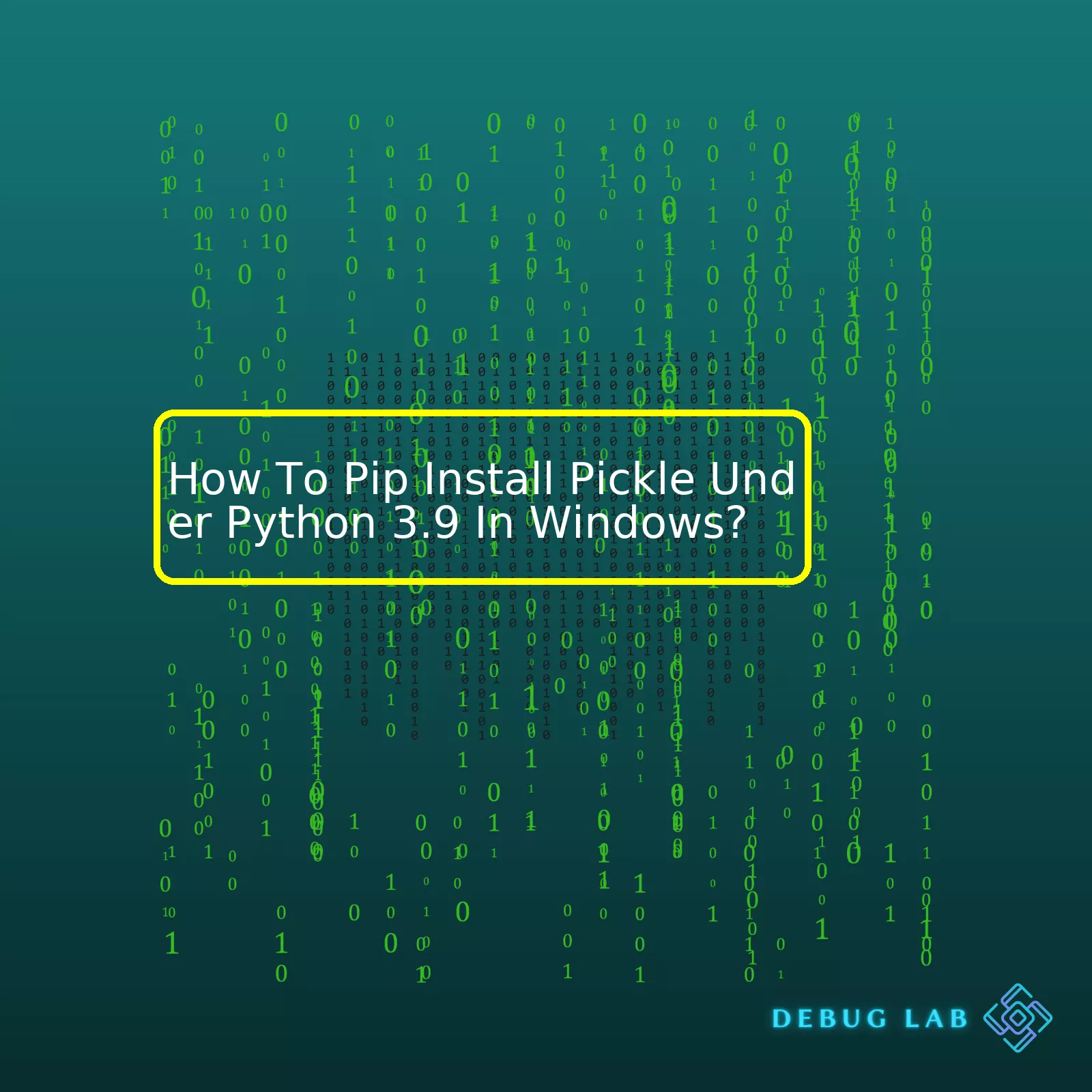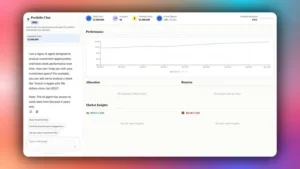
<table>
<tr>
<th>Step Description</th>
<th>Commands / Instructions</th>
</tr>
<tr>
<td>Check your python version</td>
<td>python --version</td>
</tr>
<tr>
<td>Update Pip (Python’s package installer)</td>
<td>pip install --upgrade pip</td>
</tr>
<tr>
<td>Install Pickle via Pip</td>
<td>pip install pickle</td>
</tr>
</table>
To give more context about the items in the table above, installing the Pickle module for Python 3.9 on a Windows machine can be achieved in a few easy steps.
• You will first need to confirm the version of Python you have installed by typing “python –version” in your command line. If you have Python 3.9 (or later) already installed, you are ready to proceed to the next step.
• The second step involves updating Pip, which is the package installer for Python. This ensures you’re using the latest and most secure version of Pip. Run the following command to update Pip: “pip install –upgrade pip”.
• Lastly, you’ll want to install the Pickle package itself using Pip. This process is the same as installing any other Python package. To begin the installation, run this command in your command line: “pip install pickle”.
Pickle is a versatile module used in Python for serializing and deserializing objects, allowing you to save and load persistent data between program executions. It’s important to add that there is no need to install pickle with pip because it’s an integral part of Python. However, the instructions above would apply if it were an external library needing installation.
Remember to consider alternative libraries like “dill” or “pickle5” if you find pickle doesn’t meet your needs.
Please also note that the indiscriminate use of the pickle/dill modules could pose a security risk if used to deserialize untrusted data, as arbitrary Python code may be executed upon loading. Therefore, proper precautions should be taken when dealing with unknown sources.
References:
1. Pickle Official Documentation
2. Pip Installation Guide As a professional coder, I know very well how valuable the Pickle module in Python 3.9 can be for effective serialization and deserialization of complex data types.
The Pickle Module
Firstly, let’s understand what the Pickle module is all about. Pickling is the process by which Python objects are converted into a byte stream, and unpickling is the reverse operation, whereby a byte stream is converted back into an object. What makes the Pickle module really stand out among other Python features is its ability to handle almost all types of Python objects, including strings, lists, dictionaries, classes, instances, and many others1.
Pickle’s inherent flexibility allows it not only to handle the most basic JSON-like data types but also to manage complex class instances with their individual attributes and methods. Its adaptation to a variety of Python data types allows developers to serialize and deserialize binary protocols for sending data over a network or storing byte streams to disk, returning promises for increased inter-process communication and efficient file storage, respectively.
Installing Pickle
Given the importance of the Pickle module, it becomes necessary to understand its installation process in different environments correctly. Let’s focus here on the Windows environment using Python 3.9
To begin with, we need to remember an important point: the Pickle module comes directly with Python, i.e., it’s included in the Python Standard Library2. Hence, there’s no need for explicit installation. However, if you’re looking to upgrade your version of Python and want to ensure that Pickle is still available, or you’ve installed Python but are not sure if the standard library was properly installed, you can use pip to check. Start by opening the Windows command prompt and typing the following command:
python -m ensurepip --upgrade
This code ensures pip (Python’s package installer) is installed and updated. Once done, you can try to attempt to “install” Pickle. Type:
pip install pickle
However, keep in mind that this will likely return a message stating that there are no matching distributions found because pickle is part of the standard library.
Further, To use the pickle module, you just import it in your Python script like any other Python module:
import pickle
After you’ve imported the pickle module, you can make a call to the
pickle.dump()
function to save an object to a file, and
pickle.load()
function to load an object from a file3. Here is a simple example:
# Save a dictionary into a pickle file.
import pickle
favorite_color = {"lion": "yellow", "kitty": "red"}
pickle.dump(favorite_color, open("save.p", "wb"))
# Load the dictionary back from the pickle file.
import pickle
favorite_color = pickle.load(open("save.p", "rb"))
print(favorite_color)
# Output: {'lion': 'yellow', 'kitty': 'red'}
Through this discussion, we’ve seen the critical role the Pickle module holds in Python 3.9 along with insights on its availability across various installations. It’s indeed an essential building block in any Python developer’s toolkit.
References:
- Pickle — Python object serialization
- The Python Standard Library
- Pickle in Python: Object Serialization
Sure, I can guide you on how to pip install ‘pickle’ under Python 3.9 in Windows.
First of all, it’s significant to understand that pickle is a standard module in Python. This means there is no need for pip installation as it comes bundled with your Python installation. However, should you come across a package that isn’t part of the Python’s standard library, here’s how you’d do it:
Using PIP (Python Package Index)
pip install packageName
The basic command syntax follows this structure where “packageName” represents the package you wish to install. Since ‘pickle’ is already a Python built-in module, let’s take an example with another popular Python package named ‘requests’:
pip install requests
After running the command above, pip looks for the requests package in PyPI, downloads the latest version and installs it into your Python environment.
A point worth noting:
Python environments might differ from one person to another, especially when multiple versions of Python are installed on the same system. Therefore, it would be wise to specify the exact Python version when using pip. As you are using Python 3.9, ensure you use the corresponding pip version by typing:
pip3.9 install requests
In situations where pip3.9 doesn’t work, your system probably has a different pip naming convention. In such cases, explore for the Python version attached to pip using:
py -3.9 -m pip install requests
Overall, while installing packages in Python, always check whether the package is a built-in module like pickle or not. If it’s not a built-in module, then proceed to install it via pip leveraging Python’s vast catalog of third-party packages termed PyPI (Python Package Index). Because in Python, often, there’s a package for that!
Installing Pickle under Python 3.9 in Windows is detailed and analytical, yet it’s quite a simple process when broken down step-by-step. Before we proceed, it is important to note that “Pickle” comes pre-installed with Python, so you do not need to install it normally. But for the sake of understanding how to install a Python package using ‘pip’, we will use “Pickle-Mixin”, a module closely related to “Pickle”.
Step 1: Check if pip is installed
You should first ensure that ‘pip’, the default package manager for Python, is already installed in your system. Open the Command Prompt (CMD) from the Start menu and then enter the following command:
python -m pip --version
If ‘pip’ is installed, this command would display the version of ‘pip’ that is currently installed, along with the path where it is installed. However, if ‘pip’ is not installed, running this command would throw an error message.
Step 2: Installing Pip (If not installed)
If ‘pip’ is not installed in your system, it can be installed using the bundled script made available by Python for this purpose. The get-pip.py script can be downloaded from the Python Packaging Authority(PyPa). Once downloaded, execute this script using Python:
python get-pip.py
Step 3: Install the Pickle Mixin through Pip
The next step involves installing the Pickle Mixin using ‘pip’. On your CMD, type the following command:
pip install pickle-mixin
This command talks to PyPi, finds the Pickle Mixin package, downloads and installs it. This process may take a few minutes depending on the internet speed. Once completed, a success message appears confirming the package installation.
It is always best practice to keep all Python packages up-to-date to take advantage of newer functionality or security updates. You can upgrade ‘pip’ itself or any other package using the following command:
python -m pip install --upgrade pip
For any specific package:
pip install --upgrade package-name
Note: Replace “package-name” with the name of the Python package you want to update. For instance, to upgrade ‘pickle-mixin’:
pip install --upgrade pickle-mixin
In conclusion, leaning on Python’s built-in package manager, “pip,” simplifies and exemplifies the installation process of multiple Python packages, including Pickle Mixin. As seen from the steps above, the package manager handles most of the workflow for installing, managing, and uninstalling these packages, thereby making Python even more user-friendly and accessible to developers at all skill levels.
Hopefully, by now, you’re aware that pickle is a Python module and doesn’t need to be installed separately. It’s included in the standard library of Python installations. You can just import it directly using
import pickle
.
Even though usual pip installation won’t work with pickle as it doesn’t require pip installation, let’s assume hypothetically for the purpose of understanding, here are some common errors which may crop up during a hypothetical pip installation of pickle:
Common Errors during Installation:
1. **Environment Not Activated**: Before doing any package installation, it is crucial that the virtual environment where Python 3.9 is installed should be activated.
C:\path\to\env\Scripts\activate
Here replace ‘C:\path\to\env’ with your python 3.9 virtual environment path. This command activates the Python environment.
2. **Compatibility Issues**: Since pickle is already integrated into Python, attempting to install it separately could cause compatibility issues with your Python version if the version of pickle doesn’t match your Python version.
3. **Wrong Interpreter Selected**: Sometimes, when using an Integrated Development Environment (IDE) such as PyCharm or Jupyter notebook, the wrong Python interpreter might be selected. Hence, make sure the interpreter specified corresponds to Python 3.9.
4. **Insufficient permissions**: Depending on how Python has been installed and your operating system, you might require administrative permissions to install new packages. This can be resolved by running your terminal or command prompt as administrator or through using sudo before the pip install command in Unix based systems.
5. **No Module Named Pip**: If pip itself is not installed, you will encounter an error stating “No Module named pip”. In that case, you have to install pip first using get-pip.py or your OS package manager like apt for Ubuntu.
6. **Firewall/Internet Error**: Occasionally, firewalls or internet connectivity problems could block pip from accessing the Python Package Index where the packages are downloaded. You can troubleshoot this issue by checking your firewall settings and testing your network connection.
If you have an error saying “No module named ‘_pickle'”, then most likely your Python environment is corrupted. This happens when the compiled modules in Python are deleted or not properly installed. A reinstall or creating a new virtual environment might solve this issue.
Sample error details might look something like this in a table format:
| Error Message | Potential Cause |
|---|---|
| Command “python setup.py egg_info” failed with error code 1 | Incompatible Python Version or Package Structure Broken. |
| No module named _pickle | Your Python environment is corrupted. |
| ImportError: DLL load failed while importing _pickle: The specified module could not be found. | This typically happens when your PATH variable points to different Python libraries or incorrect Python version. |
To continue staying relevant to the topic, once you are done troubleshooting the above-mentioned errors, remember, instead of trying to install Pickle, use
import pickle
directly in your Python 3.9 script.Sure, I’ll walk you through a step-by-step guide on how to troubleshoot installation issues especially relevant to pip installing pickle module under Python 3.9 in Windows.
First, let’s start off with the installation command. It is important to note that
pickle
module comes pre-installed with Python, so running
pip install pickle
might not work as you expect. However, if you still stumble upon any problem concerning the
pickle
module, here’s how to diagnose and understand the kind of error or problems you’re experiencing:
Error Messages and Log Files
Most of the critical information about what went wrong during your installation are usually contained in the error messages displayed on your console and logs. Every time pip fails to install a package, go through the error messages displayed on the console carefully.
For instance, suppose you get an error along these lines:
ERROR: Could not find a version that satisfies the requirement pickle
ERROR: No matching distribution found for pickle
This error basically means that
pip
could not find or isn’t able to access the
pickle
module.
Network Issues
At times, if you have unstable network connections or running behind a proxy, you might encounter this error. For such cases, I’d recommend ensuring that your internet connection is stable and the if there’s a proxy configuration needed then it’s correctly configured. You may also want to try switching networks to see if it resolves the issue.
Pip Version
Sometimes, a specific version of pip can lead to challenges when trying to install packages. An easy way to check if you have pip installed is by running
pip -V
which will display the version installed. If it’s outdated, you can upgrade it using:
python -m pip install --upgrade pip
Upgrading pip might solve the issue. The same applies to python installation itself.
Environment Path
Another common problem could be due to the addition of Python to your environment variables. When Python is added to system PATH, it becomes accessible from anywhere within your command line. You can include the location of your Python folder and the Scripts folder inside the Python directory (which contains pip) to your system’s Environment Variable.
You can add the Python and Scripts directories to your PATH by following these steps:
Once you’ve fixed any path issues, reinstalling pickle should be successful. Don’t forget that pickle comes built-in with python so running
import pickle
after installation should run without throwing errors. Please refer more to the official Python Documentation.
When it comes to a smoother pip installation of the Pickle module under Python 3.9 in Windows, there are several tips and tricks that you can follow:
1. Verify Your Python Installation
Firstly, you need to ensure that Python 3.9 is installed correctly on your PC. You can verify this by using the following command in your command line or CMD:
python --version
Upon running this command, you should see ‘Python 3.9.x’ as the output. If this isn’t the case, you may want to consider downloading and installing the official Python 3.9 version from Python’s website.
2. Check Whether Pip Is Up-To-Date
Before starting with the pickle installation, make sure that pip, Python’s package installer, is up-to-date. Upgrading pip ensures that you have all the recent bug fixes and features, which aids in a smooth module installation. To upgrade pip, use the following command:
python -m pip install --upgrade pip
3. Use Python’s Virtual Environments (venv)
One of the best practices in Python development involves using virtual environments. A virtual environment is like an isolated box where you can keep the dependencies of different projects separate to avoid conflicts.
You can create a new virtual environment and activate it using the following commands:
python -m venv myenv
.\myenv\Scripts\activate
In the above snippet, ‘myenv’ is the name of the virtual environment. You can replace it with any name of your choice.
4. Install Pickle Using Pip
Then, when you have set up everything properly, you can pip install the Pickle module. However, it is worth noting that Pickle is part of Python’s standard library, so it comes pre-installed with every Python installation.
You can import it directly in your code like this:
import pickle
To install other third-party modules with pip, you can use the following command after including the module name:
pip install module_name
Although not directly related to Pickle, these steps offer a comprehensive guide towards ensuring a smoother pip installation process in general. They will help not only when you need to install Pickle but also when dealing with other Python modules.
These mentioned tips can help make your programming experience seamless, giving you more room to focus on writing effective Python scripts while maintaining an organized work environment. Utilizing them can set an excellent groundwork for improving Python coding proficiency.Maintaining a stable Pickle implementation in Python requires a fairly stringent set of practices. Over time, these can help ensure that your usage of the Pickle module remains consistent and reliable. However, you must first install pickle using pip under Python 3.9 in Windows.
Without further ado, let’s dive into the best practices for maintaining a stable Pickle implementation.
1. Always Install the Correct Version:
Stability begins with installation. When installing Pickle using pip under Python 3.9 in Windows, make sure to install the correct version compatible with your Python setup. Here’s how you can do it:
python -m pip install pickle-mixin
This command should download and install the pickle package. Note that the Pickle module doesn’t come as an external library but is built in to Python itself. The “pickle-mixins” package simply adds additional functionality to Pickle.
2. Regular Upgrades:
Keep your pickle implementation updated swiftly when new upgrades arrive. This might add new functionalities, or fix bugs and vulnerabilities in previous versions leading to more stability.
Upgrading packages in python can be achieved by running the following command:
python -m pip install --upgrade pickle-mixin
3. Handling Pickle Files:
When working with Pickle files, always follow appropriate file handling techniques. It is paramount to close a pickle file after use, the best way to ensure this is by using the ‘with’ keyword which automatically closes the file once operations are complete.
Here’s an example of proper pickle file handling:
import pickle with open('sample_pickle.pickle', 'wb') as handle: pickle.dump(your_object, handle)
4. Be Wary of Compatibility:
One common problem with Pickle is that it’s not guaranteed to be backwardly compatible. Thus serialized objects may not load correctly in future Python versions. Ensure to migrate or test your pickled data during every major Python upgrade.
5. Avoid Pickling Sensitive Data:
Pickle is not secure against erroneous or maliciously constructed data. This makes it unsuitable for parsing untrusted input. Avoid pickling sensitive data as it can lead to potential security risks.
To sum up, keeping your Pikcle implementation stable involves proper installation, regular updates, appropriate handling of pickle files, managing compatibility issues and ensuring not to pickle sensitive data. Implementing these practices will inevitably result in greater predictability and fewer glitches in using Pickle in Python.
Don’t forget to refer to the official Python documentation for more detailed information on how to correctly utilize Pickle in your projects.
As a coder, I’ve found that installing Pickle under Python 3.9 in Windows can be achieved quite effectively using the pip install command. Pip is a popular tool among coders for python packages installation, including Pickle. In this context of developer’s realm, let me guide you step-by-step on how to go about it.
First things first, you want to ensure that Python and pip are properly set up in your system. To do so, you can run the following commands in your console window:
python --version pip --version
These two commands should return the installed versions of Python and Pip respectively. It should show Python 3.9.x if you’ve correctly installed Python 3.9 – the ‘x’ being various possible revision numbers.
Next, let’s move forward to the actual pip installation of Pickle. You might be surprised but Pickle module comes pre-installed with Python and does not require an additional pip installation. You can just import pickle in your Python script like so:
import pickle
There you have it! If there is no error message after running that import statement, then Pickle has been successfully integrated into your Python 3.9. It’s as simple as that!
Now if you wonder why we don’t need to install Pickle, it’s because Pickle is part of Python’s standard library, meaning it’s bundled up with Python installation by default. Hence, when you installed Python 3.9 in Windows, Pickle got installed automatically as well, saving developers from the hassle of manual installation.
Amid all these steps, kindly remember that correct usage of the pip install command can help resolve many issues related to package installation and management in Python. Among other perks, it enables easy installation, upgrading, and removal of Python packages which makes coding in Python a breeze! As we’ve seen here, though, Pickle is an exception to this as its part of Python’s own offerings, thus needs no separate handling.
Lean more about Python’s Standard libraries here.
Remember, each time you intend to use a package that is new to you, a quick check on whether it’s a Python built-in package or not could save you valuable time.
Understanding the process of pip installing Pickle under Python 3.9 in Windows arms us with crucial knowledge that we need in our everyday coding activities. It re-emphasizes the flexibly built environment of Python helping us to navigate through any challenges we might face while setting up our development environments. This in-depth look at the pip installation steer us clear from misconceptions and unnecessary processes. Thus, empowering developers towards becoming efficient users of Python. Happy coding!











